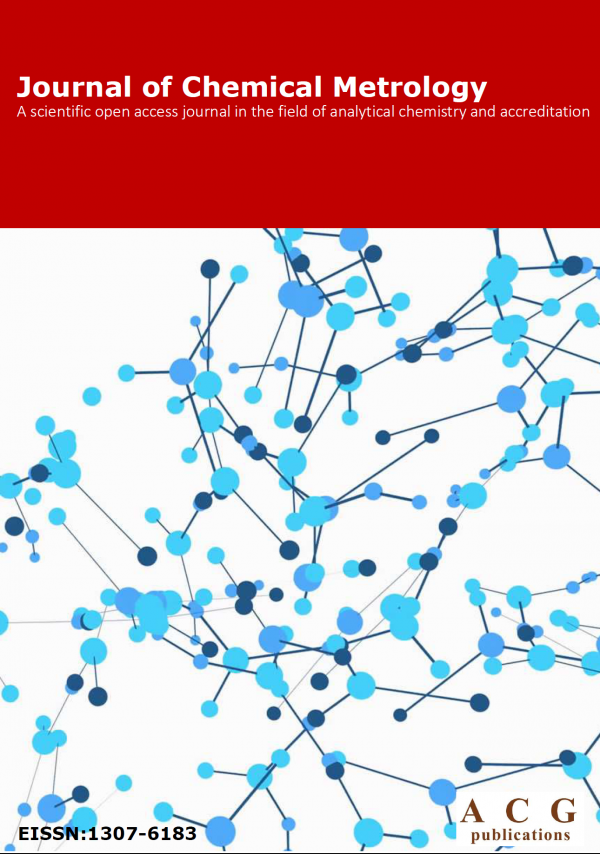Journal of Chemical Metrology
Year: 2017 Volume: 11 Issue:1
1) Concept paper on SI value assignment of purity - Model for the classification of peptide/protein purity determinations
Required metrological tools, such as higher order reference measurements procedures, pure substance and matrix certified reference materials, are established for small well defined molecules. Difficulties still remain in the provision of SI traceable standards in the area of larger biomolecules such as peptides/proteins. The provision of Primary Calibration Reference Services has been identified as a core technical competency for National Measurement Institutes (NMIs). A concept has been elaborated by the Focus Group I on peptide/protein purity for the strategic planning of ongoing Key Comparisons of the Protein Analysis Working Group (PAWG) within the Comité Consultatif pour la Quantité de Matière (CCQM). The assignment of the mass fraction content of high purity peptide/protein materials will be the subject of the CCQM-K115/P55.2 comparison series to directly support NMI services and certified reference materials currently being provided by NMIs.
DOI http://doi.org/10.25135/jcm.1.17.02.030 Keywords Peptide protein purity traceability comparison DETAILS PDF OF ARTICLE © 2017 ACG Publications. All rights reserved.2) Accurate determination of ethanol in water by qNMR: Validation and uncertainty assessment
A rapid and simple method, having high reproducibility and low uncertainty for determination of low concentration of ethanol in water has been developed by using qNMR. Method validation was performed applying CRM and calibration solutions. The correlation coefficient for the analyte in the calibration interval was 1. At a concentration range of 0.5 mg /g to 5 mg/g, the recovery was determined to be 99.71%. The relative uncertainties for ethanol solutions of 0.8123 mg/g and 3.8029 mg/g in water were found to be 0.0053 mg/g and 0.0027 mg/g, respectively.
DOI http://doi.org/10.25135/jcm.2.17.03.035 Keywords qNMR ethanol traceability method validation uncertainty DETAILS PDF OF ARTICLE © 2017 ACG Publications. All rights reserved.3) A new approach for accurate quantitative determination using fluorine nuclear magnetic resonance spectroscopy
A new approach for accurate quantitative determination by fluorine nuclear magnetic resonance ( 19F NMR) spectroscopy is presented and discussed. 19F NMR spectroscopy has similar properties to 1H NMR spectroscopy except for the wide chemical shift dispersion, which is the main difference between the two techniques. The off-resonance effect, which is caused by the chemical shift difference between the excitation pulse offset and the resonance signal position, is expected to be the most important parameter influencing the accuracy of the quantitative analysis by 19F NMR spectroscopy. We propose a new method that reduces the influence of the off-resonance effect in 19F NMR measurement. First, we discussed the areas of signals originating from different functional groups in a molecule. Then, we evaluated the areas of signals originating from two different reference materials (RMs). The accuracy of the ratios of two signal areas in the 19F NMR spectrum of a molecule of Potassium perfluorooctanesulfonate was less than 1 %. We also evaluated the purity of flusulfamide and diflubenzuron as RMs, and found that the method could determine the purity to less than 1 % accuracy relative to the reference values.
DOI http://doi.org/10.25135/jcm.3.17.03.036 Keywords qNMR 19F NMR internal standard method purity off resonance effect DETAILS PDF OF ARTICLE © 2017 ACG Publications. All rights reserved.4) Heavy metal determination of unfertilised vegetables and univariate analysis of the results
Heavy metal contamination in water and food samples is thought as the result of human activities such as agriculture, traffic and industrial process in this century. Trace metal contents in the soil have increased with the contributions of both industrial and agricultural operations. Chemical fertilizers cause unbalance of the food in the soil. When these facts considered heavy metal accumulation in the vegetables may be occurred because of the over fertilization. In recent years interest on vegetables that fertilization is not applied has increased. In this study some heavy metal contents such as Cu, Fe, Mn, Ni and Zn have determined via ICP-OES by using microwave solubilisation system in vegetable samples from four different regions on which greenhouse and chemical fertilization process is not applied. The validity of the method is controlled with certified reference material (Tomato Leaves (NIST1573a). Recovery values have found over 95 %. Univariate ANOVA test is applied on experimental results. Since Sig. value is p>0.05 and F<F k for each vegetable samples, it is seen that group variants are homogenous and there is not a significant difference between the soils of the four region.
DOI http://doi.org/10.25135/jcm.4.17.02.031 Keywords Microwave digestion heavy metal vegetable sample ICP OES DETAILS PDF OF ARTICLE © 2017 ACG Publications. All rights reserved.